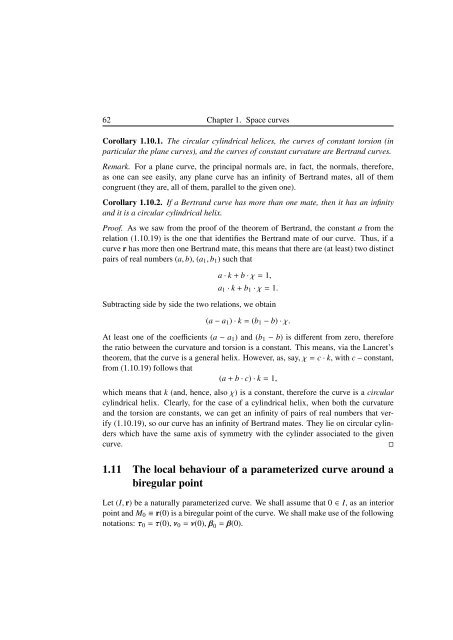Blaga P. Lectures on the differential geometry of - tiera.ru
Blaga P. Lectures on the differential geometry of - tiera.ru
Blaga P. Lectures on the differential geometry of - tiera.ru
Create successful ePaper yourself
Turn your PDF publications into a flip-book with our unique Google optimized e-Paper software.
62 Chapter 1. Space curves<br />
Corollary 1.10.1. The circular cylindrical helices, <strong>the</strong> curves <strong>of</strong> c<strong>on</strong>stant torsi<strong>on</strong> (in<br />
particular <strong>the</strong> plane curves), and <strong>the</strong> curves <strong>of</strong> c<strong>on</strong>stant curvature are Bertrand curves.<br />
Remark. For a plane curve, <strong>the</strong> principal normals are, in fact, <strong>the</strong> normals, <strong>the</strong>refore,<br />
as <strong>on</strong>e can see easily, any plane curve has an infinity <strong>of</strong> Bertrand mates, all <strong>of</strong> <strong>the</strong>m<br />
c<strong>on</strong>g<strong>ru</strong>ent (<strong>the</strong>y are, all <strong>of</strong> <strong>the</strong>m, parallel to <strong>the</strong> given <strong>on</strong>e).<br />
Corollary 1.10.2. If a Bertrand curve has more than <strong>on</strong>e mate, <strong>the</strong>n it has an infinity<br />
and it is a circular cylindrical helix.<br />
Pro<strong>of</strong>. As we saw from <strong>the</strong> pro<strong>of</strong> <strong>of</strong> <strong>the</strong> <strong>the</strong>orem <strong>of</strong> Bertrand, <strong>the</strong> c<strong>on</strong>stant a from <strong>the</strong><br />
relati<strong>on</strong> (1.10.19) is <strong>the</strong> <strong>on</strong>e that identifies <strong>the</strong> Bertrand mate <strong>of</strong> our curve. Thus, if a<br />
curve r has more <strong>the</strong>n <strong>on</strong>e Bertrand mate, this means that <strong>the</strong>re are (at least) two distinct<br />
pairs <strong>of</strong> real numbers (a, b), (a1, b1) such that<br />
a · k + b · χ = 1,<br />
a1 · k + b1 · χ = 1.<br />
Subtracting side by side <strong>the</strong> two relati<strong>on</strong>s, we obtain<br />
(a − a1) · k = (b1 − b) · χ.<br />
At least <strong>on</strong>e <strong>of</strong> <strong>the</strong> coefficients (a − a1) and (b1 − b) is different from zero, <strong>the</strong>refore<br />
<strong>the</strong> ratio between <strong>the</strong> curvature and torsi<strong>on</strong> is a c<strong>on</strong>stant. This means, via <strong>the</strong> Lancret’s<br />
<strong>the</strong>orem, that <strong>the</strong> curve is a general helix. However, as, say, χ = c · k, with c – c<strong>on</strong>stant,<br />
from (1.10.19) follows that<br />
(a + b · c) · k = 1,<br />
which means that k (and, hence, also χ) is a c<strong>on</strong>stant, <strong>the</strong>refore <strong>the</strong> curve is a circular<br />
cylindrical helix. Clearly, for <strong>the</strong> case <strong>of</strong> a cylindrical helix, when both <strong>the</strong> curvature<br />
and <strong>the</strong> torsi<strong>on</strong> are c<strong>on</strong>stants, we can get an infinity <strong>of</strong> pairs <strong>of</strong> real numbers that verify<br />
(1.10.19), so our curve has an infinity <strong>of</strong> Bertrand mates. They lie <strong>on</strong> circular cylinders<br />
which have <strong>the</strong> same axis <strong>of</strong> symmetry with <strong>the</strong> cylinder associated to <strong>the</strong> given<br />
curve. �<br />
1.11 The local behaviour <strong>of</strong> a parameterized curve around a<br />
biregular point<br />
Let (I, r) be a naturally parameterized curve. We shall assume that 0 ∈ I, as an interior<br />
point and M0 ≡ r(0) is a biregular point <strong>of</strong> <strong>the</strong> curve. We shall make use <strong>of</strong> <strong>the</strong> following<br />
notati<strong>on</strong>s: τ0 = τ(0), ν0 = ν(0), β 0 = β(0).












